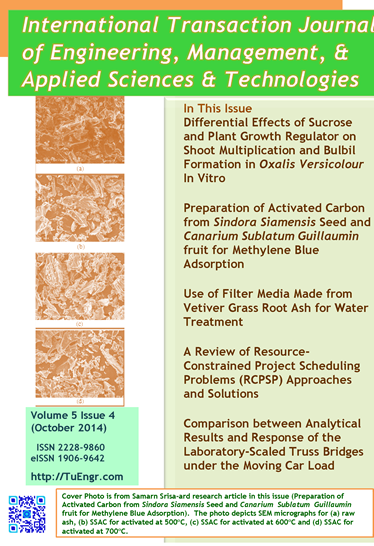- Differential Effects of Sucrose and Plant Growth Regulator on Shoot Multiplication and Bulbil Formation in Oxalis Versicolour In Vitro
 Nattapong Chanchula, Tassanai Jaruwattanaphan (Department of Horticulture, Faculty of Agriculture, Kasetsart University, Bangkhen, Bangkok, 10220, THAILAND), and Anchalee Jala * (Department of Biotechnology, Faculty of Science and Technology, Thammasat University, Rangsit Campus, Pathumthani, 12121, THAILAND)
Nattapong Chanchula, Tassanai Jaruwattanaphan (Department of Horticulture, Faculty of Agriculture, Kasetsart University, Bangkhen, Bangkok, 10220, THAILAND), and Anchalee Jala * (Department of Biotechnology, Faculty of Science and Technology, Thammasat University, Rangsit Campus, Pathumthani, 12121, THAILAND)
(Optimized )
Keywords: Bicolor Flower; Bulb; Tissue culture; NAA; BA.
Abstract
Explants from young leaves and stem nodes of Oxalis versicolour were used and cultured on MS medium supplemented with different concentration of 2,4-D. The best result showed that cluster of callus were formed and proliferated around the base of explants on MS medium supplemented with 0.1 mg/l 2,4-D. Callus transferred to MS medium supplemented with various concentrations of NAA and BA. After nine weeks, callus regenerated to be new shoots. The highest average length of stolon was from MS medium supplemented with 0.1mg/l NAA and 0.1 mg/l BA and number of plantlets was from MS medium supplemented with 4.0 mg/l NAA and 5.0 mg/l BA. Plantlets were cultured on MS medium supplemented with different concentrations of sucrose for ten weeks. It was found that all parameters: number of plantlets, bulbil sized, length of stolon, and number of nodes were significant difference (p≤0.05). Number of flowers and sized of flowers found only in MS medium supplemented with 9–10 % of sucrose.
- Preparation of Activated Carbon from Sindora Siamensis Seed and Canarium Sublatum Guillaumin fruit for Methylene Blue Adsorption
 Samarn Srisa-ard (Department of Chemistry, Faculty of Science and Technology, Rajabhat Maha Sarakham University,
THAILAND
)
Samarn Srisa-ard (Department of Chemistry, Faculty of Science and Technology, Rajabhat Maha Sarakham University,
THAILAND
)
Keywords:
scanning electron microscope;
Langmuir isotherm model;
Adsorption isotherm;
Chemical activation;
Iodine number;
Zinc chloride;
MB;
SEM;
Abstract
Activated carbons produced from Sindora Siamensis (SSAC) seed and Canarium Sublatum Guillaumin (CSGAC) fruit were prepared by chemical activation with zinc chloride, their characteristics and their methylene blue (MB) adsorptions were investigated. The effects of zinc chloride concentrations and activation temperatures were examined. The surface chemical characteristics of activated carbons were determined by scanning electron microscope (SEM). Adsorption capacity was demonstrated with iodine numbers. The Langmuir and Freundlich equilibrium isotherm theories were applied to describe MB adsorption. The equilibrium adsorption results were complied with Langmuir isotherm model and its maximum monolayer adsorption capacity for SSAC and CSGAC are 672.6 and 487.6 mg/g for MB adsorption. The value of RL was found to be below 1.0, indicating that the resultant activated carbon was favorable for MB adsorption. These results indicate that SSAC and CSGAC shells could be utilized as a renewable resource to develop activated carbon which is a potential adsorbent for MB.
- Use of Filter Media Made from Vetiver Grass Root Ash for Water Treatment
 Krittiya Lertpocasombut * (Department of Civil Engineering, Faculty of Engineering, Thammasat University Rangsit Campus, Pathumtani 12120, THAILAND ) and Maruay Onsod (Quality System & Product Auditing Manager, Goodyear (Thailand) Public Co. Ltd., Pathumtani, 12120, THAILAND)
Krittiya Lertpocasombut * (Department of Civil Engineering, Faculty of Engineering, Thammasat University Rangsit Campus, Pathumtani 12120, THAILAND ) and Maruay Onsod (Quality System & Product Auditing Manager, Goodyear (Thailand) Public Co. Ltd., Pathumtani, 12120, THAILAND)
Keywords: natural material; polyvinyl alcohol; pellet; turbidity;
Abstract
Vetiver grass and its usages have been widely reported in many researches. This research aimed to use the vetiver grass root ash (VGRA) to filter water to improve its quality. The investigation of the physical and chemical properties of the VGRA indicated the product from natural material ash could be used as a filter medium. The distribution of particle size, the specific gravity, and the Iodine number of the VGRA were determined as well as the ratio of the VGRA to polyvinyl alcohol (PVA) as a binding polymer were analyzed. The results revealed that the best mold of the VGRA pellet as a filter media was a circular shape. The ratio of the VGRA to PVA was 7.33 to 1. This was consistent with the results of the linear shrinkage that were 13.35 ± 2.10 which was the best form of the VGRA product to be used as a filter medium for water turbidity treatment.
- A Review of Resource-Constrained Project Scheduling Problems (RCPSP) Approaches and Solutions
 Mohammad Abdolshah * (Engineering Faculty, Islamic Azad University, Semnan Branch, Semnan, Iran )
Mohammad Abdolshah * (Engineering Faculty, Islamic Azad University, Semnan Branch, Semnan, Iran )
(Optimized for mobile) (mirror at slideShare) (mirror at Calameo) (mirror at ScriBd)
Keywords: Exact salvation;
Heuristics;
Meta-heuristics;
Deterministic.
Abstract
Resource-constrained project scheduling problems are one of the most famous proposed problems in operational research and optimization topic. Using of discrete models by considering complexity of the problems requires designing efficient algorithms for solving them. On the other hand, this series of topics and generally project management are given attention in recent decades. Competition features of today’s world, lead in time implementation of project with required quality to be important. Those factors lead to be given attention to resource-constrained project scheduling problems and their solutions theoretically and practically by academic researches and practitioners. The purpose of the paper is determining different methods and approaches that are used for solving the mentioned problems simultaneously or separately. The various described models in literature that consist of more than 200 published papers in most well-known journals, are collected and proposed in table format. In this research by studying these papers, in addition clarifying features of the developed models and the gaps, practitioners of projects implementation in various organizations can choose appropriate model for their projects by considering organizational conditions, types of resources and their organization’s activities’ technological specifications.
- Comparison between Analytical Results and Response of the Laboratory-Scaled Truss Bridges under the Moving Car Load
 Surachet Charnrit, Weerayut Krahothong, and Chaisak Pisitpaibool * (Department of Civil Engineering Faculty of Engineering, Thammasat University, THAILAND )
Surachet Charnrit, Weerayut Krahothong, and Chaisak Pisitpaibool * (Department of Civil Engineering Faculty of Engineering, Thammasat University, THAILAND )
Keywords: Laboratory scaled model;
Moving car load;
Static loading;
Unexpected truss behavior.
Abstract
Two sets of the two traditional types of the laboratory-scale -parallel chorded truss bridges under the moving car loads are conducted. Both steel bars used to assemble the bridges and a miniradio-controlled kid-car used as the applied loads are selected from materials available in the market. The experimental programs address the unexpected rebound behavior of the vertical deflection of a truss model under the low speed of the moving car loads. This behavior, however, cannot be detected by the traditional and numerical analysis methods. The rebound behavior of the model may require further investigation.



 ** Read Full Issue @ Calameo
** Read Full Issue @ Calameo Nattapong Chanchula, Tassanai Jaruwattanaphan (Department of Horticulture, Faculty of Agriculture, Kasetsart University, Bangkhen, Bangkok, 10220, THAILAND), and Anchalee Jala * (
Nattapong Chanchula, Tassanai Jaruwattanaphan (Department of Horticulture, Faculty of Agriculture, Kasetsart University, Bangkhen, Bangkok, 10220, THAILAND), and Anchalee Jala * ( Samarn Srisa-ard (Department of Chemistry, Faculty of Science and Technology, Rajabhat Maha Sarakham University,
THAILAND
)
Samarn Srisa-ard (Department of Chemistry, Faculty of Science and Technology, Rajabhat Maha Sarakham University,
THAILAND
) Krittiya Lertpocasombut * (Department of Civil Engineering, Faculty of Engineering, Thammasat University Rangsit Campus, Pathumtani 12120, THAILAND ) and Maruay Onsod (
Krittiya Lertpocasombut * (Department of Civil Engineering, Faculty of Engineering, Thammasat University Rangsit Campus, Pathumtani 12120, THAILAND ) and Maruay Onsod ( Mohammad Abdolshah * (Engineering Faculty, Islamic Azad University, Semnan Branch, Semnan, Iran )
Mohammad Abdolshah * (Engineering Faculty, Islamic Azad University, Semnan Branch, Semnan, Iran ) Surachet Charnrit, Weerayut Krahothong, and Chaisak Pisitpaibool * (Department of Civil Engineering Faculty of Engineering, Thammasat University, THAILAND )
Surachet Charnrit, Weerayut Krahothong, and Chaisak Pisitpaibool * (Department of Civil Engineering Faculty of Engineering, Thammasat University, THAILAND )